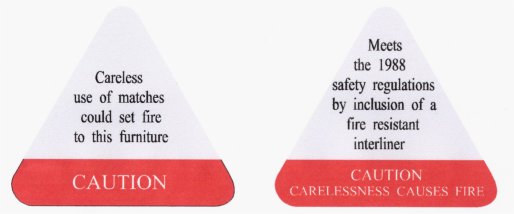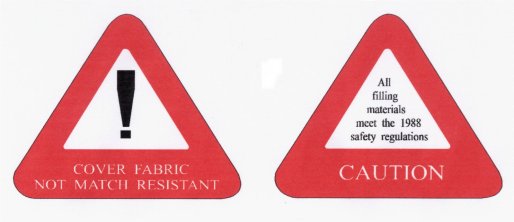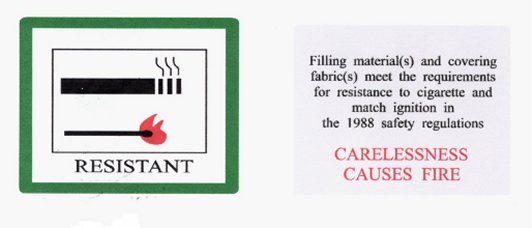Furniture and Furnishings (Fire Safety) Regulations 1988/1989, 1993 and 2010
The Furniture and Furnishings (Fire Safety) Regulations 1988 (as amended in 1989, 1993 and 2010) set levels of fire resistance for domestic upholstered furniture, furnishings and other products containing upholstery. This page is intended to give an overview of the responsibilities of companies involved in the supply of upholstered furniture and is intended to help suppliers of these products understand how the new Regulations may affect them. It is not an authoritative interpretation of the Regulations, which is a matter for the courts. The Regulations like most legislation is difficult to fully understand consequently two guides have been published to assist the lay person to understand the regulations more fully. This page provides an overview but it does not cover all the details. You should refer to the FIRA’s Guide to the UK Regulations for more detailed information.
The Regulations are enforced by the Trading Standards Department. If you need advice, clarification or additional information contact them by using their website, telephone or go personally to the local office which will be a department of your local Council.
The guide combined with the regulations should answer any question you have. These can be downloaded from the following links:-
- The Statutory Instrument 1988 No. 1324, the Statutory Instrument 1989 No. 2358 , the Statutory Instrument 1993 No. 207 and Statutory Instrument 2010 No 2205
- The Furniture Industry Research Association (FIRA) Guide to the UK Regulations.
Summary
The Furniture and Furnishings (Fire Safety) Regulations 1988 (amended 1989, 1993 and 2010) are UK law and are designed to ensure that upholstery components and composites used for furniture supplied in the UK meet specified ignition resistance levels and are suitable labelled. There are six main elements contained within the Regulations:
- Filling materials must meet specified ignition requirements
- Upholstery composites must be cigarette resistant
- Covers must be match resistant (with certain exceptions as outlined in Section 8.2 and Appendix A5)
- A permanent label must be fitted to every item of new furniture (with the exception of mattresses
and bed-bases) - A display label must be fitted to every item of new furniture at the point of sale (with the exception of mattresses, bed-bases, pillows, scatter cushions, seat pads, loose covers sold separately from the furniture and stretch covers)
- The first supplier of domestic upholstered furniture in the UK must maintain records for five years to prove compliance. The requirements regarding testing and labelling of items are detailed in Schedules 1-7 of the Regulations. Schedules 1-5 provide detailed information regarding the testing requirements for foam and non-foam fillings, composites, interliners and covers. Schedules 6-7 provide detailed information regarding the display and permanent labelling of the final item.
Suppliers who may be affected
The Regulations apply to all persons in the business supply chain from the supply of materials for use in
furniture through to the supply of the finished article as well as re-upholstery and re-covering. They affect:
- Persons who supply furniture, furnishings or re upholstery services including:
- Manufacturers
- Retailers
- Importers
- Persons who supply filling materials and fabrics to the furniture industry or direct to consumers
- Persons who supply re-upholstery and re-covering services
- Persons who supply second-hand furniture in the course of business or trade (e.g. auctioneers,
charities).
The Regulations also apply to persons who hire out furniture in the course of a business. This embraces furniture included in accommodation let in the course of business, such as holiday homes and residential furnished lettings (including houses, flats and bed-sits). As such, the Regulations apply to landlords, estate agents and letting agents who let such accommodation. The first supplier of domestic upholstered furniture in the UK is the person responsible for ensuring that the Regulations are met. In this context, the definition of the first supplier in the UK with respect to manufacturers, importers and retailers is important.
Specific responsibilities relating to other sectors include charities, letting, holiday homes and furnished residential properties, chalet hotels and holiday apartments, sheltered accommodation, care homes and student accommodation, Canal boats and pleasure craft, caravans, landlords, estate agents and letting agents, auctioneers and persons who supply furniture as part of a statutory functions.
All the above is fully explained in the FIRA guide.
Product ranges covered by the Regulations
Products covered by the Regulations comprise six groups (A to F)
A) All types of upholstered seating including chairs, settees, padded stools and ottomans. Children’s furniture, foot stools, sofa-beds, futons and other convertibles, bean bags and floor cushions, nursery furniture and upholstered items designed to contain a baby or small child. Domestic upholstered furniture that is supplied in kit form for self-assembly. Second hand furniture, upholstered head-boards, footboards and side rails of beds.
B) Furniture for use in the open air (garden and outdoor furniture) which is suitable for use in a dwelling (homes and caravans), upholstery in caravans (although not vehicles or boats). Cane furniture which includes upholstery.
C) Divans, bed-bases, mattresses, pillows, and mattress pads (toppers) (FILLING MATERIAL ONLY)
D) Scatter cushions and seat pads (FILLING MATERIAL ONLY)
E) Permanent covers for furniture (textiles, coated textiles, leather, etc) Loose and stretch covers for furniture. Covers for non-visible parts of furniture
F) Foam and non-foam filling material for furniture
All furniture and products in the above groups need to comply with the Regulations. The specific information and exceptions to each group are discussed separately in the FIRA guide.
The Regulations do not apply to furniture intended for export and furniture manufactured prior to 1950.
The Regulations do not apply to sleeping bags, bedclothes (including duvets), loose covers for mattresses (i.e. mattress protectors), pillowcases, curtains and carpets. However, it is important to note that these products are covered under General Product Safety Regulations 2005 (GPSR).
Testing
Manufacturers, importers and retailers in the UK need to ensure that:
- Furniture is not supplied which contains foam fillings (block or crumb polyurethane or latex rubber) that do not meet the requirements outlined in Schedule 1 of the Regulations
- Furniture is not supplied which contains non-foam fillings that do not meet the requirements outlined in Schedule 2 of the Regulations.
- Composite fillings consisting of more than one filling material comply either by each individual filling separately complying or by the total composite being tested. In either case, any foam incorporated in the composite must comply with Schedule 1 of the Regulations.
- Furniture is not supplied with upholstery composites that do not pass the cigarette test as outlined in Schedule 4 of the Regulations.
- Furniture is not supplied with permanent, loose or stretch covers which do not pass the match test as outlined in Schedule 5 of the Regulations.
The testing requirements for items are more fully explained in the FIRA guide.
Labelling
Display labelling
Display labelling is required to indicate the ignition resistance of each item of furniture and needs to be attached to all new furniture at the point of sale, with the exception of mattresses, bed-bases, pillows, scatter cushions, seat pads, loose covers (sold separately from the furniture) and stretch covers.
Furniture sold as a collection of items, such as three piece suites or a set of dining chairs must carry the appropriate display label on each individual item. In all cases the display label must be attached to the furniture in a prominent position so that the label will be clearly visible to a potential purchaser of the furniture and the wording on both sides can be read with reasonable ease.
Appropriate to new furniture which meets the filling requirements and is cigarette resistant. This applies to the likes of baby nests and the word “product” may be substituted for the word “furniture” on the second side of this label.

Appropriate to new furniture with a limited range of cover fabrics. The cover fabric is not match resistant, but the furniture has an interliner which passes the specified test. The furniture meets the filling requirements and is cigarette resistant.

Appropriate to new furniture which meets the filling requirements and is both cigarette and match resistant.

Permanent labelling
Permanent labelling on furniture is intended to assist enforcement officers and show compliance with the specific ignition requirements for covers and fillings. The prime objective of the permanent label is for enforcement officers to examine a label on a piece of furniture and obtain relevant information which will enable them to find out and confirm that the materials used in the item do comply with the Regulations. They will also be able to complete a cross check of the claims being made on the label with the manufacturers records. Permanent labels need to be carried on all items of furniture with the exception of mattresses divans and bed bases. The labelling specifications for mattresses, divans and bed-bases are covered separately by BS 7177.
There are two versions of permanent labels that manufacturers and importers can choose from.
These are:
- A label giving full information about the furniture
- A shorter label giving only the minimum information about the furniture.
A full description of what must be included in these labels is given in Parts 2 and 3, respectively, of Schedule 7 of the Regulations. It is important to emphasise that the actual design of the permanent label is left entirely to the manufacturer or importer. However, the requirements regarding the information that appears on the labels, the minimum size of letters and position and durability of the label must be followed.
Record keeping
All manufacturers, importers and retailers are required to keep records to ensure traceability and compliance of all items of upholstered furniture. Such information must include:
- Statements from suppliers
- The results of any relevant test that have been carried out on the furniture and its components
- The correlation of test results to specific items of furniture
- The correlation of records to labels, batch numbers or marks attached to the furniture.
Manufacturers and importers need to retain the information for a period of five years from the date on which the furniture is supplied to the retailer.
Retailers
If a piece of furniture is supplied which carries only the short permanent label, then the retailer needs to ensure that the manufacturer or importer (or any intermediary supplier) provides the details of the
following:
- Name and postal code of the address of the first supplier in the UK (i.e. manufacturer or importer)
- Date on which the article was manufactured or imported
- Description of all the filling materials included in the article
- Description of all the covering materials included in the article.
It is strongly advised that retailers obtain a Certificate of Compliance to the Furniture and Furnishings (Fire Safety) Regulations 1988 from the manufacturer or supplier/importer.
Categories:Fire Safety Legislation
March 28, 2011[Last updated: February 9, 2022]
Comments are closed here.